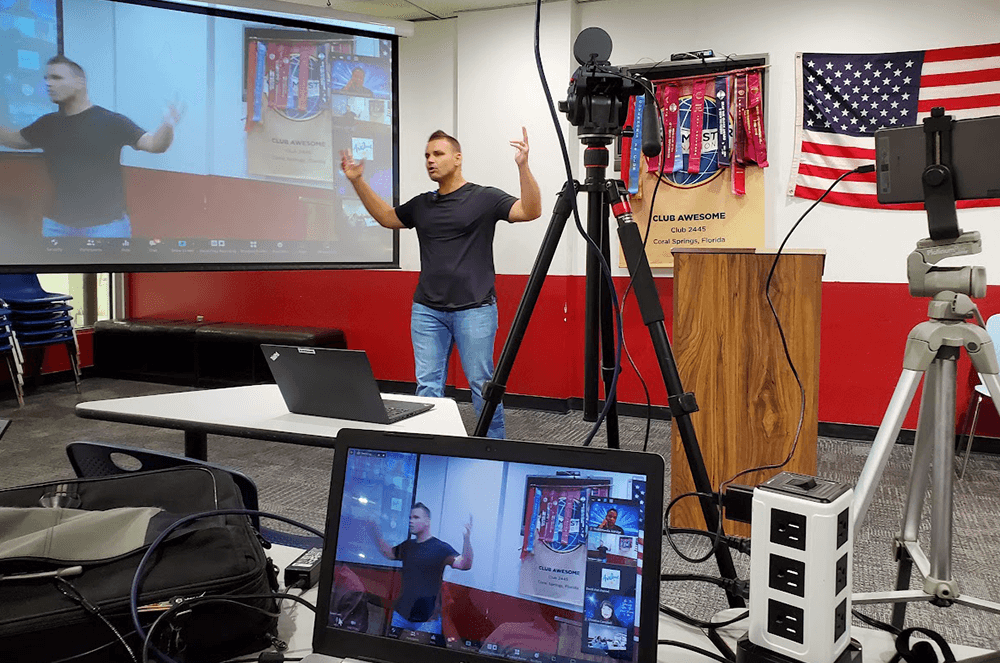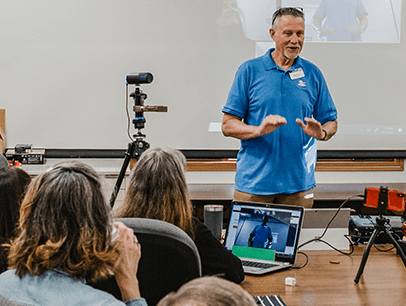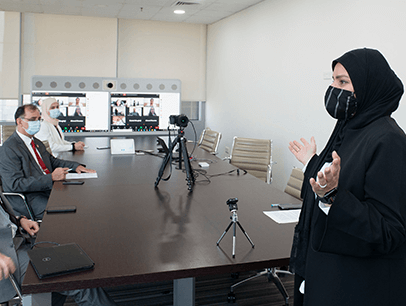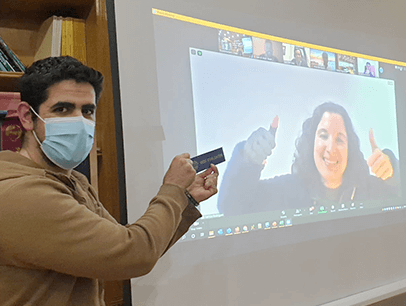
Conducting hybrid meetings can be challenging, particularly with all the technology options available. However, hybrid meetings are worth pursuing, as they are a great way not only to connect with members and guests outside your geographic area but also to learn professional skills that are increasingly valuable in the workplace.
Despite the potential benefits, going hybrid is not the right choice for every club, so you’ll want to evaluate your options (and have your club vote on the decision).
My home club, Club Awesome in Coral Springs, Florida, began holding hybrid meetings shortly before the pandemic. Perfect timing, because we were ready when so many clubs started transitioning to online meetings. Since then, I’ve been helping club members and leaders adapt.
Getting People to Show Up—In Person and Online
Of course, none of the technical details matter unless club leaders and club members are committed to making the hybrid format work.
“If there are only three or four people in the room, then you have to ask, ‘how many people will come next time? If only that many, should we just meet online?’” says Cajetan Barretto, DTM, Vice President Education, Kuwait Challengers Club in Kuwait City, Kuwait.
Barretto has been active in training on online and hybrid meeting technologies in District 20 and worldwide through his YouTube channel Tech for Toastmasters. He has also run District and professional hybrid events. However, the challenge is different at the club level, where smaller numbers make achieving the right balance harder.
Agnieszka “Aggie” Ilnicka, President of Framingham/Natick Toastmasters in Framingham, Massachusetts, says when her club first considered what to do, most members said they had been attending too many Zoom meetings during the workday and were eager to attend evening meetings in person.
However, not all members live in driving distance, so the club went hybrid, something fellow club member and Vice President Membership Tracy Eisenman, who lives three states away in Pennsylvania, appreciated. She joined the club when it was fully online. “I felt like they went hybrid to keep me in the club, which was kind of cool,” she says.
Your club will have to find its own balance.
Weighing the Options
The technical elements of the hybrid format are speaker and microphone (audio), camera or cameras along with a TV or projector (video), and, of course, internet access. In general, I recommend going beyond what’s built into a laptop.
Audio
Contrary to what you might think, the audio rather than the visual component of the video stream is what’s most important for effective communication. Common problems include the echo and distortion that occur if multiple people in a meeting room join the online session with their audio turned on. Only one computer should have audio input and output active.
The main audio feed should be clear enough that online participants can hear those in the room and vice versa.
If you’re using Zoom, the “Leave Audio” option (found on the up arrow menu next to the microphone icon) lets you quickly mute both mic and speaker. Or you can change your settings to have Zoom always prompt you whether to activate computer audio.
Both Barretto, of Kuwait, and hybrid meetings expert Markus Seppälä, DTM, of Basel International Speakers in Basel, Switzerland, recommend using a conference room speakerphone placed near the speaking area. (Seppälä has compiled a list of equipment recommendations.) My club has a speakerphone but also invested in a wireless microphone. We often leave it on the lectern, but it can be clipped to the speaker’s clothing.
Click play to hear an exclusive interview with Toastmaster Markus Seppälä and the hosts of the Toastmasters Podcast.
Video
A camera mounted on a tripod will allow you to aim the camera more effectively. Three options to consider are:
- An external webcam with a tripod mount, which is what my club uses.
- A digital SLR camera that can be connected to a computer with a USB cable. This is what Cam Krook, DTM, who serves in District 69’s club promotion coaching and technical support position, recommends.
- A smartphone clamped into a tripod mount. Barretto uses this option with the camera in selfie mode, allowing speakers to see themselves on screen.
If practical, adding one or more additional cameras aimed at the audience can help online participants see what is happening in the room. This can be a smartphone or a tablet.
Finally, in order for in-room participants to see online speakers, you will also need a TV or projector. Again, these can be as basic or fancy as your budget allows.
Internet access
Ideally, your meeting location will provide free, fast, and reliable Wi-Fi. If that is not available, or it fails on a given meeting day, it’s possible to run a Zoom meeting off the Wi-Fi hotspot built into a member’s smartphone. Or consider purchasing a dedicated 5G wireless hotspot device.
Finding the Tech Balance
A good hybrid meeting should be good for everyone, whether attendees are in person or online. A bad hybrid experience tends to be particularly bad for the online participants, who feel left out when they can’t see or hear what’s happening in the room.
Every club has different needs: A club that meets in a corporate meeting room or university lecture room with technology for conducting hybrid classes will have different needs than a club that meets in a church basement with no equipment. A club with reserves of money will have more options than one that must either collect money for equipment or depend on members to provide equipment. A club full of IT and audiovisual professionals won’t have the same hurdles as one made up of technically challenged folks.
Krook, District 69’s technical support specialist, is also a business systems analyst, as well as a consultant and trainer in the Agile project management methodology. But he says everything he has learned about audio-visual tech comes from learning by doing in Toastmasters. Before deciding what your club needs, he recommends doing a “needs assessment,” where you assess where you are starting from in terms of requirements, meeting venue, existing technology, and the technical skills of your members.
“Preparation is key, as it is in so many situations,” Krook says.
Should you keep it simple, using only the camera and microphone built into a laptop? That’s essentially what Framingham/Natick Toastmasters has been doing. The club does take advantage of a couple of smartphones (volunteered by members in attendance) acting as additional cameras. Ilnicka, of Framingham/Natick Toastmasters, notes that they started out using a more complicated setup, then made a conscious decision to simplify.
One of their members donated a laptop, making the club’s only purchase a 220 USD projector. External speakers turned out to be unnecessary because the projector had a built-in speaker. The only other gear the club might consider purchasing is an external webcam, she says.
The challenge of going hybrid is different at the club level, where smaller numbers make achieving the right balance harder.
My club, Club Awesome, has spent upward of 1,000 USD, because we had the money and club leaders believed we should spend what was required to make hybrid meetings successful. We decided the club should own the essential equipment, rather than being dependent on equipment provided by a member—where if that person doesn’t show up, the meeting can’t go on. Standardizing equipment as much as possible also helped us get multiple people trained to set up the room and the tech.
Your budget is dependent on your club’s needs and situation—you’ll need more funds if you’re starting from zero, but you may be able to spend less if you get donations, or your meeting venue provides the essentials.
Providing a good experience for both online and offline participants is easier said than done. The technical part is important, but less so than the member experience created by club leaders. Members who feel their presence is valued will be more patient with the technical misadventures that occur along the way and more committed to making hybrid work for the club.
David F. Carr, DTM is a writer, editor, and digital consultant based in Coral Springs, Florida. He is a member of Online Presenters and of Club Awesome in Coral Springs. He is also the founder of the WordPress for Toastmasters project and runs the Toastmost.org club website hosting service.
Related Articles

Online Meetings
To Hybrid or Not to Hybrid? That is the Question.

Online Meetings
Technology for Hybrid Meetings

Online Meetings



 Previous
Previous

 Previous Article
Previous Article